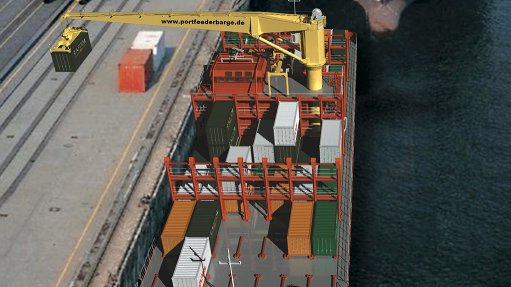
Sandock Austral Shipyards has launched a port feeder barge that it believes will “revolutionise the way containers are handled in South African ports”, ultimately leading to less road congestion and faster turnaround times for imports and exports.
The internationally patented, German-designed self-propelled and self-sustained barge can be deployed at a moment’s notice to wherever it is needed and can operate easily in low water depth, or high berth, says the company.
The barge acts independent from quayside equipment and can be used to move containers from different points within the port.
The key element of the port feeder barge concept is its own full-scale container crane.
Durban, like Lagos or even Hamburg, has a lot of container movement within the port from one terminal to another which requires the use of trucks, explains Sandock Austral Shipyards.
Containers also need to be carried for stuffing and stripping activities to off-dock facilities, which often have their own (shallow) water access, but no cranes, resulting in additional road haulage.
The port feeder barge eliminates this, so there is less traffic congestion.
The port feeder barge has a myriad of uses as it can be deployed as a floating (and self-sustained) container truck for haulage within ports or to nearby locations (such a container freight stations) or as a floating terminal for deep-sea container vessels at anchorage, coastal shipping or inland navigation.
It can also be used as a floating crane for non-containerised cargo.
Sandock Austral Shipyards marketing officer Suhaila Gobey says the hybrid concept is ultimately an eco-friendly logistics innovation for ports that could help to ease congestion and reduce the environmental impact of heavy container trucking in many container ports.
“Sandock Austral Shipyards signed the agreement to introduce the design in order to considerably improve the internal container logistics in many major and minor container ports.
“By introducing such a type of vessel, midstream operation becomes much more efficient and cost effective for operators.”